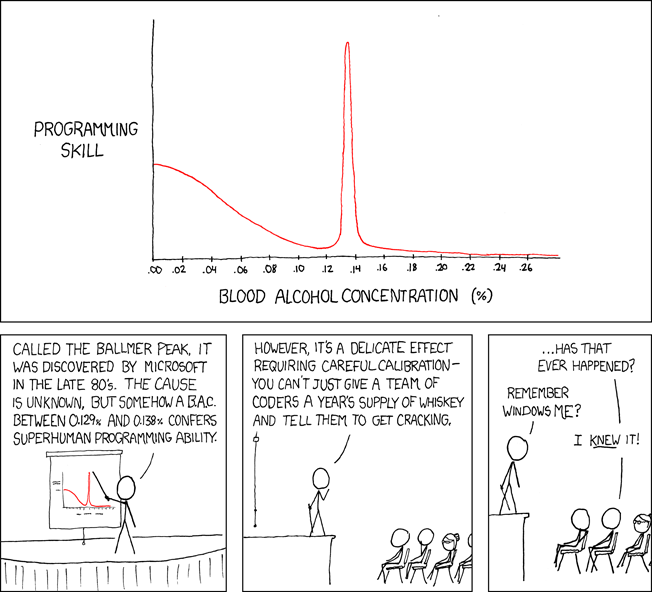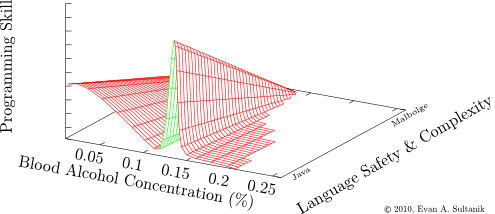
I was unaware of the Ballmer Peak (named for Microsoft’s 30th employee and former CEO Steve Ballmer) until today, but it’s an interesting idea, although there are some who believe it just may be an elaborate joke. In a nutshell, it’s the idea “that having a BAC in the 0.129% – 0.138% range can improve your cognitive abilities,” and it’s supposedly an effective technique to help with computer programming. Another way it’s been described is that “alcohol improves cognitive ability, up to a point,” and that it’s apparently a variation of the Yerkes–Dodson law, which says “that performance increases with physiological or mental arousal, but only up to a point.” xkcd described it with this cartoon:

Obviously, it may sound like bunk, but there has been earlier evidence of Creativity & Beer and also Caffeine Vs. Alcohol: Which One Better Enhances Creativity?. There’s also a lot of anecdotal evidence that alcohol can trigger creativity and/or create the conditions for new types of thinking to occur if in that sweet spot of not too drunk, and not too sober. Certainly there’s a rich historical record of books and songs created by writers and composers who were under the influence. And there was a great Bill Hicks bit about how if you think there are no positive aspects to drugs, he suggests burning all of the music that you love, because so many of the musicians who wrote it were “really fucking high.” Naturally, Bill put it much better than I ever could:
“You see, I think drugs have done some good things for us. I really do. And if you don’t believe drugs have done good things for us, do me a favor. Go home tonight. Take all your albums, all your tapes and all your CDs and burn them. ‘Cause you know what, the musicians that made all that great music that’s enhanced your lives throughout the years were rrreal fucking high on drugs. The Beatles were so fucking high they let Ringo sing a few tunes.”
Recently, however, there was an article in the Observer whose headline was “The Ballmer Peak Is Real, Study Says.”
A recent study at the University of Illinois tested the creative problem solving ability of a group of men who were given vodka cranberry and snacks and asked to solve brain teasers. The results were starkly different for the tispy group, which had a blood alcohol concentration level of 0.075, versus the control group:
Astonishingly, those in the drinking group averaged nine correct questions to the six answers correct by the non-drinking group. It also took drunk men 11.5 seconds to answer a question, whereas non-drunk men needed 15.2 seconds to think. Both groups had comparable results on a similar exam before the alcohol consumption began.
The study notes that the Ballmer Peak effect was present for creative problem solving but not for working memory.

Also, on the skeptics forum on Stack Exchange, someone asked if the Balmer Peak was real, and one of the answers posted was this:
[An] article by Norlander [link no longer working] specifically studies the relationship between moderate alcohol consumption (1.0ml/kg body weight) and creativity. According to my very rough calculations, this would correspond to a BAC in the range of 0.12–0.14 for a 73kg human. The paper concludes
…modest alcohol consumption inhibits aspects of creativity based mainly on the secondary process (preparation, certain parts of illumination, and verification), and disinhibits those based mainly on the primary process (incubation, certain parts of illumination, and restitution).
In other words, moderate alcohol consumption does improve certain types of creative thinking, while inhibiting other types of creative thinking. Since the skills required for computer programming are solely cognitive in nature (discounting the motor skills required to type, of course), and given that creativity is a large part of computer programming, it is at least plausible that one might gain some amount of improvement from alcohol consumption.
There have also been studies on the relationship between alcohol consumption and creative output. That study examined 34 well known, heavy drinking, 20th century writers, artists, and composers/performers. It concludes:
Analysis of this information yielded a number of interesting findings. Alcohol use proved detrimental to productivity in over 75% of the sample, especially in the latter phases of their drinking careers. However, it appeared to provide direct benefit for about 9% of the sample, indirect benefit for 50% and no appreciable effect for 40% at different times in their lives. Creative activity, conversely, can also affect drinking behavior, leading, for instance, to increased alcohol consumption in over 30% of the sample. Because of the complexities of this relationship, no simplistic conclusions are possible.
So for a small portion of people there was a notable increase in creative output as a result of alcohol intake. It does appear that the study did not control for the quantity of alcohol intake, though, so this may not be directly applicable to the Ballmer Peak.
The best study I was able to find on the subject was by Lapp, Collins, and Izzo. They gave subjects vodka tonics of varying strengths (by varying the ratio of tonic to vodka), some of which did not even contain any alcohol. The subjects believed that they were drinking a standard-strength vodka tonic. The subjects then were asked to perform a number of cognitively and creatively challenging tasks. Here is what they conclude:
The present results support the idea that creative people probably gain inspiration from consuming alcohol …, but show that this effect may be due to the expected rather than the pharmacological effects of the drug. … A convergence of evidence supported the idea that creativity is enhanced (at least in some aspects) by the expected effects of alcohol.
In other words, alcohol can improve certain aspects of one’s cognitive ability, but this effect is not likely due to any pharmacological process (i.e., it is often sufficient to merely believe that one is drinking alcohol in order to achieve the same benefit).
And remember: The Ballmer Peak, as it is currently understood, is but a two dimensional projection of what in reality is a higher dimensional space, vi&.

The Ballmer Peak-a-Thon even has a Ballmer Calculator you can use to determine how much to drink to reach maximum effectiveness.
